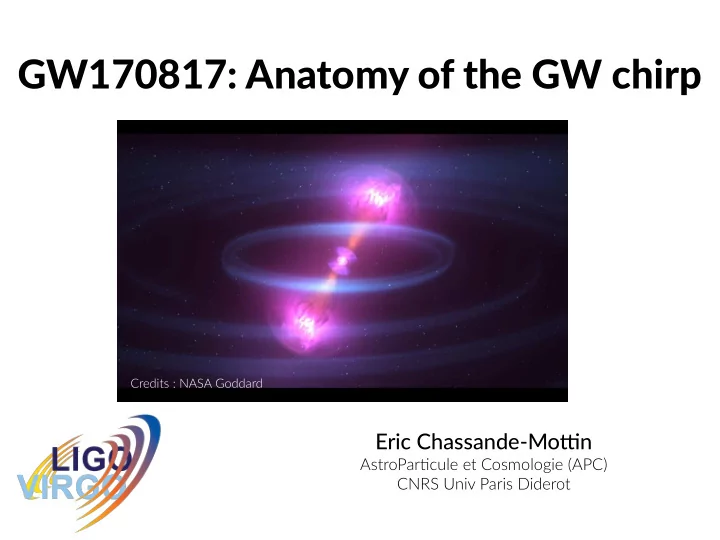

GW170817: Anatomy of the GW chirp Credits : NASA Goddard Eric Chassande-Mottjn AstroPartjcule et Cosmologie (APC) CNRS Univ Paris Diderot
Outline ● GW170817 from a GW-only perspectjve – Basics about the chirp and some details about its analysis – What can we learn from the GW signal alone? – Next steps and prospects
chirp mass
LIGO-Virgo LIGO only (190 deg 2 ) LIGO-Virgo sky localizatjon rapid (31 deg 2 ) fjnal (28 deg 2 )
Alert tjmeline t c + 40 min: 1 st LV announcement candidate BNS in H1 associated with GRB large glitch in L1 issue with V1 data transfert t c + 1h05 : Fermi report preliminary localizatjon = 1100 deg 2 t c + 1h30 min: LV update H1-only loc. and distance = 37 ± 12 Mpc t c + 5h : LIGO Virgo loc. = 30 deg 2 distance = 40 ± 8 Mpc Too late for Australia and South Africa!
Glitch story DAC saturatjon in test mass positjon feedback control
Glitch rate during O1 1 per ~20 mins If the glitch rate remains the same, > 10 % probability that a loud glitch overlaps with a 100-s GW signal
post- merger matuer/tjdal efgects inspiral
Inspiral (point partjcle approx.)
Source parameters (1) GW signal is described by 15 parameters (masses and spins + tjme/space ● locatjon and orientatjon) Parameter estjmates obtained by fj fjttj ttjng the waveform coherently in all ● detectors using Bayesian sampling methods Waveform phase determined to lowest order by chirp mass ● Phase matching: measurement accuracy scales with 1/N cycles With N cycles ≈ 3000 from 30 to 1000 Hz detector-frame chirp mass … then mass ratj tjo, spins and matu tuer efg fgects
Source parameters (2) Some of the parameters are degenerate, e.g., distance vs inclinatjon ● Can be converted to source frame by assuming a ref. cosmology (Planck) ●
equal mass – 1.36 M sun chirp mass uncertainty Updated, more precise estjmates coming soon Abbotu et al, Phys. Rev. Letu. 119, 161101 (2017) (betuer calibratjon, waveforms models, use of EM informatjon)
Tidal deformation by the gravity gradient due to companion changes the grav. potentjal and thus the orbital motjon/GW signal Effect observable in the final tens of GW cycles before merger f GW > 400 Hz – Keplerian orbital radius ~ 60 km comparable to NS radius tjdal/matuer efgects
Constraints on NS deformability and EoS of cold dense matuer NS radius (EoS) Tidal deformability mass Love number (EoS) excluded small star Update coming soon (betuer param estjmates, waveforms systematjcs, direct constraints on EoS) Selectjon of EoS from J. S. Read et al large star Phys. Rev. D79, 124032 (2009) and refs therein
Post-merger scenarios prompt collapse to a black hole → quasi normal mode at 6 kHz – hypermassive NS; livetjme ~ 1 s [preferred] → f-mode at 2-4 kHz – supramassive NS; livetjme ~ 10−10 4 s – → magnetar, bar mode or stable NS – r-mode instability post- merger
Agnostjc search for GW transients (up to 4 kHz) with short (< 1 s) and intermediate (< 500 s) duratjons No evidence for a post-merger signal h rss < 2-8 ×10 −22 Hz −1/2 Deeper and more complete search Abbotu et al, (including long duratjon, days) coming soon Astrophys. J. Letu. 851, L16
Implicatjons of GW170817 (besides GRB astrophysics) Coincidence with GRB170817A within 1.7 s ● Very stringent constraints on the speed of gravity |c/c g – 1| < 5 x 10 -16 ● Incompatjble with a large set of alt. gravity scalar-tensor theories ● brought forward to explain dark energy htups:/ /arxiv.org/abs/1710.05901 htups:/ /arxiv.org/abs/1710.05877
Open data for open science htups:/ /www.losc.ligo.org ~1 hour about each detectjon Open data workshop with online tutorials and videos
Concluding remarks ● Plenty of physics with the GW170817 chirp Binary parameters obviously but also physics of NS/EoS of dense matuer – and tests of post-merger scenarios Tests of General Relatjvity (GW polarizatjons, dipole radiatjon, etc) – ● Importance of seeing the same source in GW and EM for fundamental physics Unantjcipated implicatjons on fundamental physics (alt. models for – gravity, limit on num of spacetjme dimensions) ● Future is bright 1–50 BNS expected in O3 (12 months) – 4-80 BNS/yr for 2020+ at/near design sensitjvity –
EoS of cold dense matuer
1 st Fermi localizatjon with dashed lines
Priors ● Masses (detector frame): uniform in [0.5,7.7] M sun and chirp mass in [1.18, 2.17] M sun ● Spins: uniform in mag up to 0.05 (low spin) and 0.89 (high spin), isotropic/uncorrelated ●
Recommend
More recommend